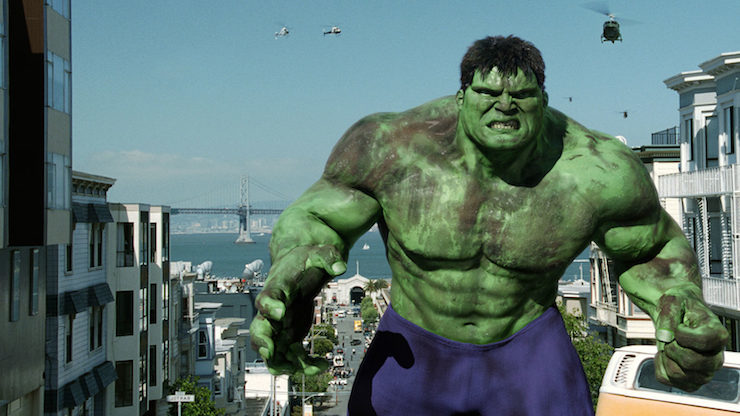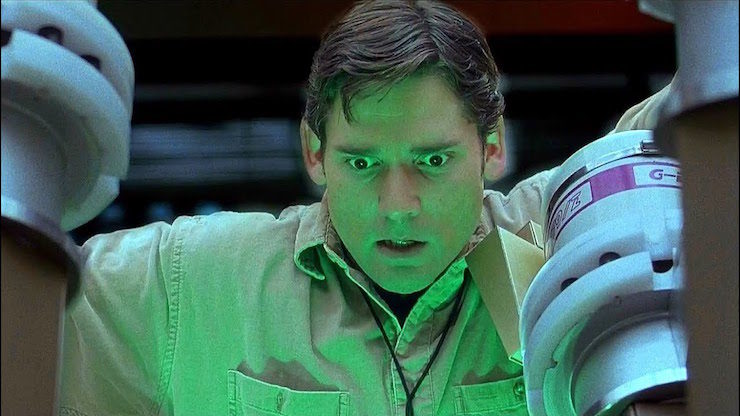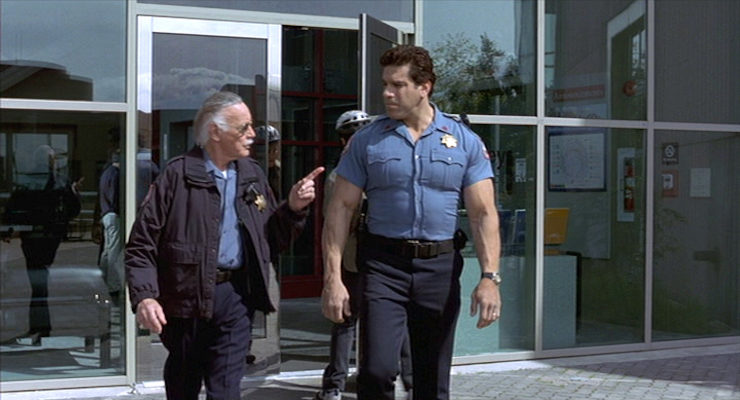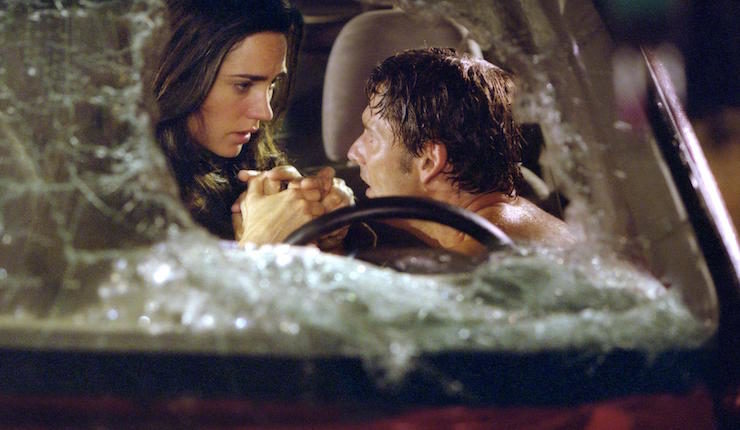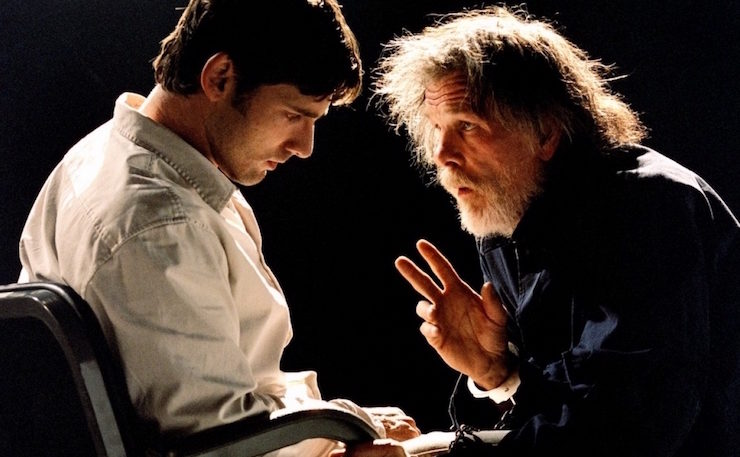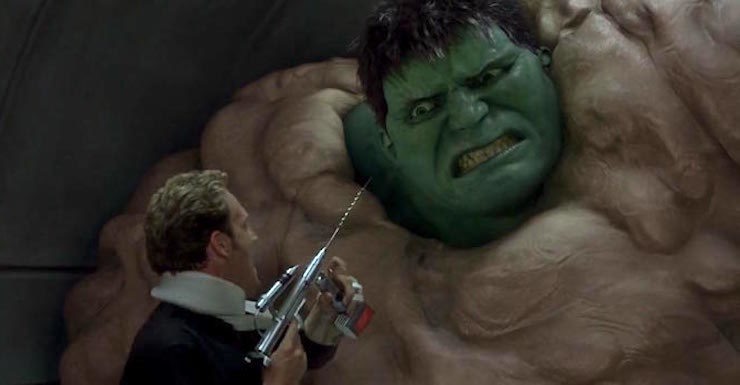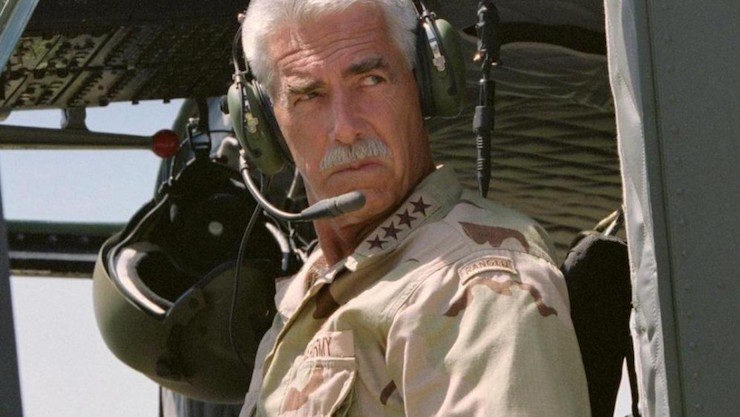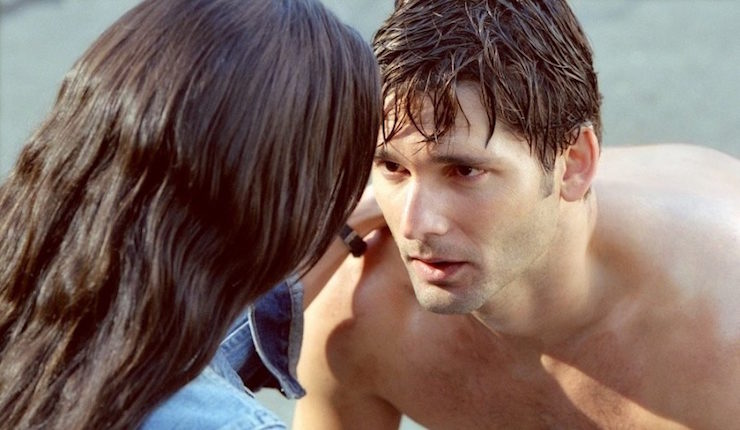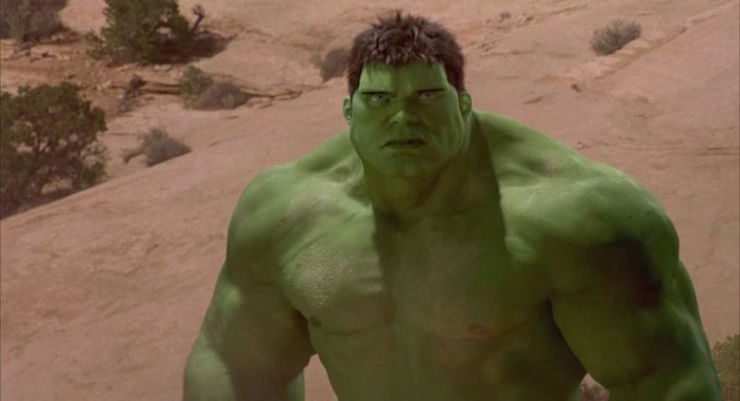A movie featuring the Hulk—the only Marvel character whose 20th-century adaptation to the screen could be considered an unqualified success—was first hatched by Avi Arad at Marvel and Gale Anne Hurd as early as 1990, shortly after The Death of the Incredible Hulk aired. They sold the rights to Universal, and that started a lengthy development process that saw numerous scriptwriters and directors brought in. At various points, Joe Johnston and Jonathan Hensleigh were attached to direct before Ang Lee was hired.
A Taiwanese director, Lee came to prominence as the director of Emma Thompson’s adaptation of Jane Austen’s Sense and Sensibility. But it was more likely his genre film Crouching Tiger, Hidden Dragon that got him the gig directing a comic-book movie…
While the movie went through an absurd number of script drafts, one element that was in most of them was a part of Bruce Banner’s backstory that wasn’t actually introduced until a 1985 issue of The Incredible Hulk written by Bill Mantlo, twenty-three years after the character was created. In issue #312 of the comic, we learn that Banner came from an abusive household, that his father Brian beat his mother—eventually to death—and badly mistreated young Bruce as well. The character’s hyper calm, his nerdy exterior, was brought into focus as an extreme reaction to his father’s anger and abuse.
Later, Peter David would use this as the basis to have Banner be diagnosed with an extreme form of what is now referred to as dissociative identity disorder, with the Hulk’s various personalities over the years (the erudite but snotty gray version we first saw when the character was created, the “Hulk smash!” green version that talks like a five-year-old that is the best known iteration of the character, and Banner himself) expressing themselves in much more extreme form.
Before Lee was brought in to direct, the draft of the script that had been done by David Hayter (who worked on the first two X-Men films) involved not only the Hulk, but also the Leader, the Absorbing Man, and Zzzax as the villains. Lee’s production partner, James Schamus, was brought in as a producer and also did a further rewrite of the script, removing the Leader entirely and combining the Absorbing Man and Zzzax with Banner’s father, making Bruce’s relationship with his father a present-day element rather than backstory. Lee got Nick Nolte to play David Banner (renaming him from Brian as a tribute to the TV series), selling it to him as being like a Greek tragedy about fathers and sons. Eric Bana was hired to play Banner after several other actors turned it down, among them Edward Norton, who would wind up replacing Bana five years later when the character was folded into the Marvel Cinematic Universe with The Incredible Hulk. Rather than hire a different actor to play the Hulk, as the TV show had done with Lou Ferrigno, the Hulk was created using computer generated imagery based on Bana’s face. (Further appearances by the Hulk on screen in The Incredible Hulk, Avengers, Avengers: Age of Ultron, Thor: Ragnarok, and the forthcoming Avengers: Infinity War would also be done this way, though these subsequent films made more extensive use of motion-capture technology, which was still a relatively new part of the cinematic toolbox when Hulk was being made.)
The other element of the Hulk’s comic book roots that was a part of most drafts of the script was the pursuit of the Hulk by General Thaddeus “Thunderbolt” Ross, who was played by Sam Elliott, as well as Banner’s relationship with Ross’s daughter Betty, played by Jennifer Connelly.
After ten years of development hell, the hiring of Lee in 2001 finally put the film on track. It’s perhaps not a coincidence that the movie settled down after the success of Blade and X-Men, and while the film was being made, Sam Raimi’s Spider-Man (which we’ll cover next week) was also a big hit in 2002. After years of success on the small screen, and after three straight Marvel-based hits on the big screen, the audience was primed to see the jade giant in theatres.
“Because he is unique, the world will not tolerate his existence”
Hulk
Written by James Schamus and Michael France and John Truman
Directed by Ang Lee
Produced by Avi Arad and Larry J. Franco and Gale Anne Hurd and James Schamus
Original release date: June 20, 2003
We open in the early 1960s, as Dr. David Banner is experimenting on trying to transfer the regenerative abilities of starfish and some amphibians and lizards to humans. He’s working on Desert Base, a U.S. Army installation, under the command of Thaddeus Ross. David experiments on himself, unbeknownst to anyone, and some time after he does so, his wife Edith announces that she’s pregnant.
Whatever David did to himself was passed on to his son, Bruce, and David continues to observe him for four years—until Ross pulls the plug on his experiment. Furious, David sabotages the base, causing a nasty explosion. He also decides that his son is a freak who needs to be killed, but he accidentally kills Edith instead when she tries to stop him. David is institutionalized, Bruce represses the memory of what happened, and he’s adopted by the Krenzler family.
Three decades later, Doctors Bruce Krenzler and Betty Ross (daughter of Thaddeus, who is now a three-star general) are working on a project very similar to David’s, but using gamma radiation to enhance nanobots that would be able to heal people. Unfortunately, every test results in the test animal exploding. Betty and Bruce are also former lovers, but they split up because Bruce was too emotionally reserved. Bruce rides to work every day on his bicycle, always saying hi to the security guards who look just like Stan Lee and Lou Ferrigno.
General Ross’s former adjutant, Glen Talbot, is now working for Atheon, a Defense Department contractor. Talbot wants to buy Bruce and Betty’s lab and use their work for the military, but neither is particularly interested.
Harper, the lab assistant, gets stuck in the equipment, and Bruce has to yank him out—but something gets knocked out of whack and the machine activates. Bruce stands in front of Harper and takes the full brunt of the irradiated nanomeds. However, instead of killing him like it did everyone else, it makes him stronger. His arthritic knee is healed, and he feels better than he ever has.
There’s a new janitor on the night shift, and he has broken into Bruce and Betty’s lab more than once. He also visits Bruce in his hospital bed and claims to be his father, but Bruce insists that his father is dead. Becoming agitated, Bruce transforms into a giant green rage monster who trashes the lab.
Ross comes to the lab and is convinced that Bruce is continuing his father’s work, possibly in collaboration with him, but Bruce insists he has no memory of his father, nor has he had any contact with him (except he has, as the new janitor really is David, but Bruce doesn’t believe him). Ross puts Bruce under house arrest, to his and Betty’s annoyance.
David has three dogs, on which he experiments using Bruce’s DNA taken from a hair he retrieved from the lab. He sends them to attack Betty, and then calls Bruce and tells him that he’s done that. Predictably, this pisses Bruce off, and then Talbot shows up to taunt Bruce, which puts him over the edge: he Hulks out, badly injures Talbot and his guards, and goes to rescue Betty. He fights off the three mutated dogs, and saves Betty, changing back to Bruce thanks to her calming influence.
Frightened of what Bruce has become, Betty reluctantly calls her father, who take Bruce into custody and sedate him. Betty convinces Ross to let her try to help him, and she takes him to the house he grew up in. He starts to remember bits and pieces of his childhood with the Banners.
David re-creates the accident where Bruce was irradiated, but father doesn’t turn into a green rage-monster like his son—instead he gains the ability to absorb the properties of anything he touches.
A decision has been made over Ross’s head to study Bruce and try to figure out what makes him tick. Atheon gets that contract, and Talbot is thrilled at the chance to make money off of this transformation and also to get revenge on Bruce.
Betty is sent home, where she finds David has broken into her home. He offers to turn himself in as long as he gets to talk to his son first.
Talbot underestimates how powerful the Hulk is: when Talbot triggers the transformation, he breaks through the isolation tube, isn’t affected by the gas they use to try to sedate him, and he pounds his way through the steel and concrete walls.
Ross is given the go-ahead to stop the Hulk any way he can. The Army and National Guard throw everything they can at the Hulk as he leaps through the desert. Nothing works, though the Hulk also makes an effort not to kill anyone. Eventually, he works his way to San Francisco. Ross and Betty both realize that he’s heading home and Betty convinces her father that she can calm him down. Sure enough, the Hulk is cornered but he calms down when he sees Betty. She approaches him, and he turns back into Bruce and allows himself to be taken into custody.
For no good reason that any sane human can see, Ross agrees to David’s terms, and allows him to see Bruce. Bruce is hooked up to a massive dose of electricity so they can fry him if he tries anything. However, he’s not the problem, David is, and the elder Banner rants for quite some time taunting Bruce, trying to get him to Hulk out. Then when Bruce responds, Ross orders the juice turned on—but David is able to absorb the electricity, turning into a giant creature made entirely of electricity. Bruce Hulks out, and their fight takes them to a lake. David’s goal is to absorb Bruce’s power, so Bruce decides to let him take all of it—and the Hulk’s tremendous power overloads David.
Ross orders a missile strike, which seems to kill Banner père et fils both.
A year later, Ross calls Betty, telling her about “Hulk sightings” that have become as common as UFO sightings. She insists she hasn’t heard from Bruce, and Ross is generally convinced that Bruce is dead—and Betty’s phone and computer are both tapped in any case. Meanwhile, in the South American rain forest, a clinic for poor people is raided by the military government. The doctor who runs the clinic is a bearded American who tells the leader of the raiding party that he’s making him angry, and you wouldn’t like him when he’s angry.
“You weren’t that hard to find”
Ang Lee made a good Hulk movie. Unfortunately, he put twelve minutes of the most mind-numbingly boring backstory material before it and added a second climax after it that served no purpose except to be annoying and make you want to gnaw your leg off at the knee. As a result, the actual movie Hulk is pretty mediocre.
If the movie had actually started twelve minutes in when Bruce is bicycling to the lab, it would’ve been perfect. The stuff that happens (for very generous definitions of the verb “to happen,” as it’s horrendously paced, boring, uninteresting, and tiresome) in the first twelve minutes should have been saved for later in the movie when Bruce himself remembers it—let the audience go on the same journey as our main character. And then, we’re treated to more backstory as we get Harper, Betty, and Bruce telling us about Bruce and Betty’s past relationship rather than actually showing us their relationship. (Also why is Harper named Harper when he should be named Rick Jones?)
So fifteen minutes into the movie, and we’ve already got two classic storytelling mistakes: not starting at the actual beginning of the story and telling rather than showing. Not encouraging.
After that, things improve some. Eric Bana is his usual bland self, but they lean into that, as Bruce is supposed to be bland, by way of contrast to his green-skinned alter ego. Jennifer Connelly is usually amazing, though she spends far too much time staring with her mouth open. As for Sam Elliott, he was pretty much born to play General Ross. He’s perfect in the role of the Hulk’s oldest enemy.
Sadly, Elliott’s the only antagonist who is compelling. Josh Lucas is only about halfway to a two-dimensional performance as Talbot. (Adrian Pasdar’s interpretation of the character on Marvel’s Agents of S.H.I.E.L.D. is way more fun.) And both Nick Nolte and Paul Kersey combine to make David Banner one of the most annoying characters in superhero cinema.
One of the reasons why the reveal about Brian Banner being abusive in the comics worked so well is because it was strong backstory for Bruce. It explained his personality, and set the stage for providing a psychological basis for his transformations into the Hulk.
But it also really works better as backstory, not frontstory. David Banner has far too intrusive a presence in this movie, and none of it actually makes the movie any better. In addition to the incredibly uninteresting scenes of him doing research in the 1960s that grinds the early minutes of the movie to a halt, he also dominates the wholly unnecessary second climax.
The emotional catharsis of this movie is the moment when Betty calms Bruce down enough in San Francisco (at what looks like the base of the squiggly part of Lombard Street, though I might be wrong about that). That should have been it, aside from a denouement that maybe had the Hulk escaping custody (I can think of about fifty ways that could’ve been accomplished) and Ross ordering a missile strike, and then they think he’s dead, and then we could have the same ending.
But David Banner is not necessary to this movie, and he sucks all the air out of it. Because we waste time on his research, on his mutant dogs, on his attempts to get at Bruce, we don’t actually spend enough time with the title character. Time that could have been spent showing us Bruce’s repressed emotions instead of having other people talk about it.
And finally we get that wholly unnecessary second climax. We’ve already seen the Hulk break out of buildings, leap around the desert, throw tanks about, get shot at by missiles, and do property damage in San Francisco. We don’t need him to have a CGI fight against his father doing a weird combination of the Absorbing Man, Zzzax, and Hydro-Man.
Speaking of CGI, the technology isn’t quite up to what the moviemakers want it to be. One of the things that took a while for CGI to nail was handling weight. For acrobatic characters like Spider-Man and Daredevil, the airiness and seeming weightlessness and near-insubstantiality of CGI works in their favor as they bound along the rooftops. But for the Hulk, it doesn’t work so well. I never believed he had the mass to leap tall buttes in a single bound or throw a tank around. (It didn’t help that he kept not causing as much damage as he should when he lands on things.) One thing they did do well, though, are the Hulk’s facial expressions. Besides looking very much like Bana, the Hulk’s emotions can be seen, from his anger and frustration to his desire to not hurt people any more than he has to, even going so far as to jump onto a fighter plane that’s about to crash into the Golden Gate Bridge, thus forcing the plane down under the bridge, saving both pilot and people on bridge.
Being on such a bell curve makes the movie look worse than it is, as it starts out horribly and leaves a bad taste in your mouth as you finish it, which takes away from the decent movie in the middle.
Over the next three weeks, we’ll look at Marvel’s other big hit of the early years of the new millennium, Sam Raimi’s Spider-Man films, starting with 2002’s Spider-Man.
Keith R.A. DeCandido will be a guest at the Doctor Who convention (Re)Generation Who 4 this weekend in Baltimore, alongside three of the Doctors—Peter Capaldi, Colin Baker, and Peter Davison—as well as actors Michelle Gomez, Janet Fielding, William Russell, Nicola Bryant, Sarah Sutton, Matthew Waterhouse, Mark Strickson, Michael Jayston, John Leeson, and Terry Molloy; voice actor Lisa Greenwood; director Rachel Talalay; fellow writers Paul Magrs, John Peel, Rob Shearman, Nev Fountain, and Arnold T. Blumberg; director/producer Jason Haigh-Ellery; cartoonist Simon Fraser; performers Cat Smith, Hannah Harkness, and Antipode Geek Bellydance; and lots more. Keith will have a table where he’ll be selling and signing books and crafts, and will also be doing panels and presentations, and also moderating Peter Davison, Janet Fielding, Sarah Sutton, and Matthew Waterhouse for a panel on the 19th season of the show (Davison’s first as the Fifth Doctor). Check out his full schedule here.










